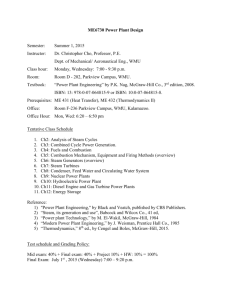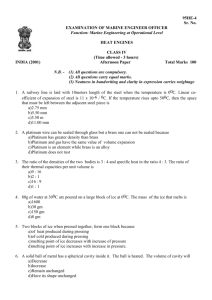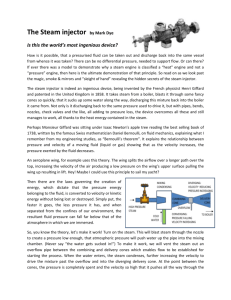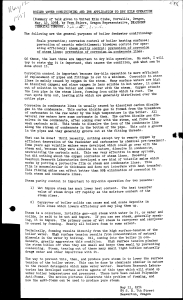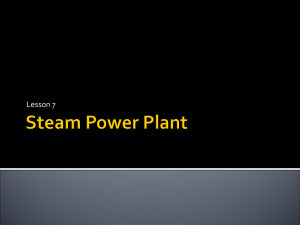Oct
advertisement
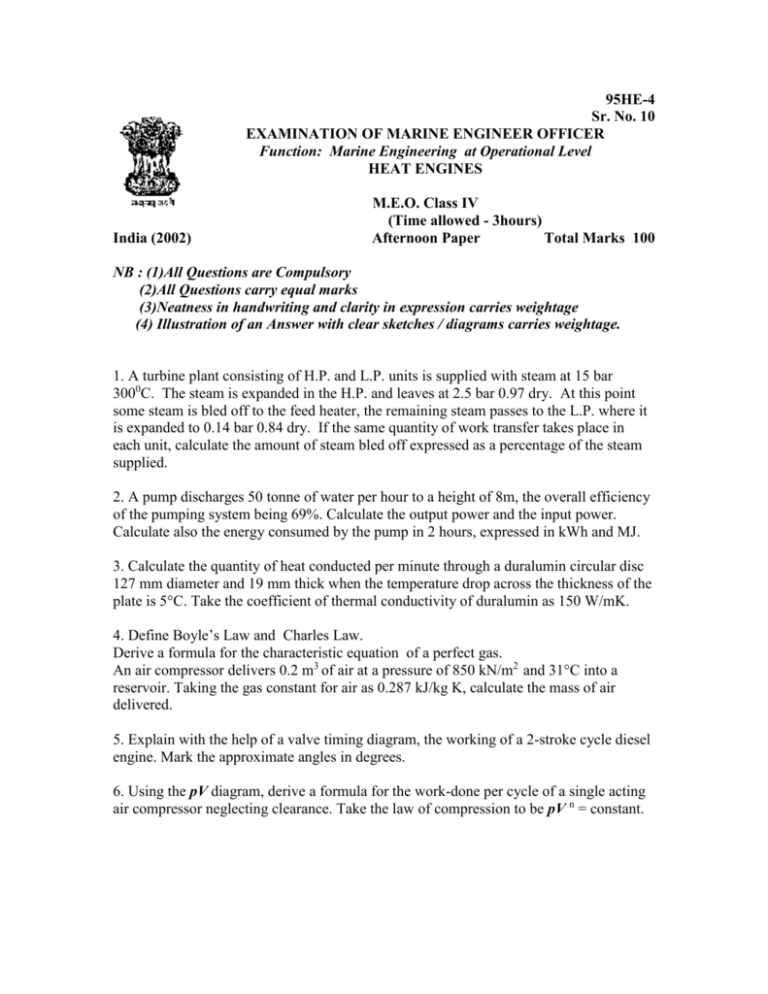
95HE-4 Sr. No. 10 EXAMINATION OF MARINE ENGINEER OFFICER Function: Marine Engineering at Operational Level HEAT ENGINES India (2002) M.E.O. Class IV (Time allowed - 3hours) Afternoon Paper Total Marks 100 NB : (1)All Questions are Compulsory (2)All Questions carry equal marks (3)Neatness in handwriting and clarity in expression carries weightage (4) Illustration of an Answer with clear sketches / diagrams carries weightage. 1. A turbine plant consisting of H.P. and L.P. units is supplied with steam at 15 bar 3000C. The steam is expanded in the H.P. and leaves at 2.5 bar 0.97 dry. At this point some steam is bled off to the feed heater, the remaining steam passes to the L.P. where it is expanded to 0.14 bar 0.84 dry. If the same quantity of work transfer takes place in each unit, calculate the amount of steam bled off expressed as a percentage of the steam supplied. 2. A pump discharges 50 tonne of water per hour to a height of 8m, the overall efficiency of the pumping system being 69%. Calculate the output power and the input power. Calculate also the energy consumed by the pump in 2 hours, expressed in kWh and MJ. 3. Calculate the quantity of heat conducted per minute through a duralumin circular disc 127 mm diameter and 19 mm thick when the temperature drop across the thickness of the plate is 5°C. Take the coefficient of thermal conductivity of duralumin as 150 W/mK. 4. Define Boyle’s Law and Charles Law. Derive a formula for the characteristic equation of a perfect gas. An air compressor delivers 0.2 m3 of air at a pressure of 850 kN/m2 and 31°C into a reservoir. Taking the gas constant for air as 0.287 kJ/kg K, calculate the mass of air delivered. 5. Explain with the help of a valve timing diagram, the working of a 2-stroke cycle diesel engine. Mark the approximate angles in degrees. 6. Using the pV diagram, derive a formula for the work-done per cycle of a single acting air compressor neglecting clearance. Take the law of compression to be pV n = constant. 7. In an experiment to determine the dryness fraction of steam, a sample at a pressure of 1.1 bar was blown into a vessel containing 10 kg of water at 15C. The final mass of water in the vessel was 10.75 kg and the final temperature 55C. Find the dryness fraction of the steam, taking the water equivalent of the vessel as 0.45 kg. 8. Steam is supplied to the cylinder of an engine at 8.3 bar and cut-off takes place when the piston has travelled 0.45 of its stroke. The clearance volume is equal to 5% of the stroke volume. If the back pressure is 2.4 bar, calculate (a) the hypothetical mean effective pressure, (b) the actual mean effective pressure taking a diagram factor of 0.72. 9. During a test on an oil-fired water-tube boiler the following data were recorded: Pressure of steam = 25 bar Temperature of steam = 300C Mass of feed water entering boiler = 11350 kg/h Temperature of feed water = 100C Mass of fuel burned = 875 kg/h Calorific value of fuel = 42.3 MJ/kg Calculate the efficiency of the boiler. 10. Freon-12 leaves the condenser of a refrigerating plant as a saturated liquid at 5.673 bar. The evaporator pressure is 1.509 bar and the refrigerant leaves the evaporator at this pressure and at a temperature of -5C. Calculate (a) the dryness fraction of the refrigerant as it enters the evaporator, (b) the refrigerating effect per kg. -------------------------X-----------------------






